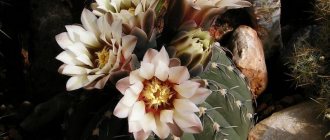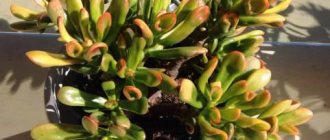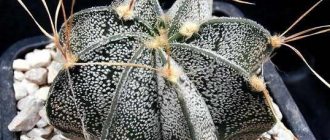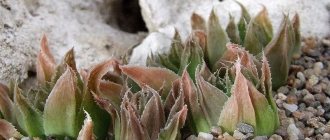Common names: Astrophytum myriostigma. Astrophytum polystylata. Bishop's cap
Family: Cactaceae
Synonyms : Astrophytum coahuilense, Astrophytum columnare, Astrophytum nuda, Astrophytum prismaticum, Echinocactus myriostigma
Plant sale
Astrophytum Myriostigma Nudum
190 rub. 300 rub.
Astrophytum asterias ASCAP
1200 rub.
Astrophytum asterias (stellate)
1100 rub.
Distribution and Habitat: Astrophytum myriostigma is a species of cactus native to the highlands of northeastern and central Mexico. Astrophytums inhabit predominantly sunny southern and eastern slopes on calcareous formations, rarely growing in the north or west between white-gray stones in loose or dense vegetation, which mainly consists of a community of dry shrubs.
Description: Astrophytum myriostigma are desert cacti, each of which has an unbranched stem that is roughly spherical in shape - often becoming elongated as the plant ages (becoming cylindrical after a few years) - and which is divided into wide three to eight segments with ribs with sharp edges.
The mostly green stem does not have a thorn, but is covered with tiny tufts of silvery hairs (looking like scales or spots). They give the plant a grayish tint. In mature cacti, the lower part of the stem tends to become woody. Grows up to 70-100 cm in height and 10-2 cm in diameter.
Once the plant matures, funnel-shaped flowers emerge from areoles near the top of the stem; each flower lasts only a few days, but the plant continues to bloom throughout the spring and summer. The flowers of all forms are bright yellow and grow about 5 cm wide. These cacti can take up to six years to bloom.
Classification and description of the cactus Astrophytum myriostigma (speckled)
Plant classification
Scientific name: Astrophytum myriostigma Synonyms: Echinocactus Myriostigma, Astrophytum Columnare, Astrophytum Nuda, Astrophytum Prismaticum, Astrophytum Tulense Common name: Astrophytum myriostigma, Astrophytum speckled, Astrophytum innumerable, Astrophytum polystigma Family: Cactaceae (Cactaceae) Subfamily: Cacto ideae Genus: Astrophytum (Astrophytum)
Astrophytum myriostigma, known in the West as bishop cactus or bishop's cap, is a species of flowering cactus in the family Cactaceae. This fascinating plant is native to the highlands of central and northeastern Mexico. This thornless species grows at altitudes of 750 to 1500 meters above sea level on rocky, limestone soils. Habitat: Overgrown plains or steep slopes facing east or west.
Photo of cactus Astrophytum speckled or polystylata in the desert of Mexico
Astrophytum myriostigma or speckled is a thornless succulent plant, a columnar cactus when young has the appearance of a small spherical plant with usually 5, sometimes 4 (or 3) well-formed ribs, which increase with age to eight or more (rarely even 10). The cross-section of the stem resembles a perfect star shape, giving the plant the appearance of a bishop's miter (hence the name bishop's cap).
The stem of the cactus takes on a shape from spherical to cylindrical; at age it grows to 60-100 cm in height (sometimes up to 1.5 m) and 10-20 cm in diameter. The color is bright green, covered with many small white hairy scales that give it a characteristic silvery-white appearance. The scales consist of very fine intertwined hairs. The roots of Astrophytum speckled are thin and fibrous.
The stem is globose to cylindrical, bright green and covered with many tiny white hairy scales. The cactus grows up to 1 m in height and up to 20 cm in diameter. Young plants have a spherical shape, resembling a ball. However, as the plants grow, they develop white hairy scales at the edges, turning into a star shape with 5 protruding ribs. They resemble the episcopal miter, which is the traditional headdress of bishops. This is where the common name for the cactus in Western countries comes from - episcope's cap.
However, please note that the number of ribs may vary. Many plant cultivars may have only 2-3 ribs, and in more rare cases, up to 10 ribs. The growth rate of cactus is slow and the plant takes a long time to grow and produce flowers.
Blooming cactus Astrophytum myriostigma
The glossy yellow daisy-like flower of Astrophytum myriostigma adds to the beauty of the plant. The flower emerges from the areoles at the tip of the stem of a mature plant and is usually no more than 5 cm in diameter and up to 7 cm long. Flowering lasts approximately 2 days.
Yellow flowers with red or orange centers appear in spring or early summer. Despite the slow growth rate, with proper care, even young plants can bloom. Astrophytum flowers have a faint sweet smell. The fruits are up to 2.5 cm in diameter, greenish to brownish-red in color, covered with brown, overlapping scales with long hair in the axils.
Growing conditions
Astrophytum came to us from very dry areas of Mexico and Texas. It is drought-resistant and light-loving.
The best windows for it are southern and southeastern. At the end of spring, when the first rays of the sun begin to shine through the window glass, the plants need to be shaded. You should gradually get used to the hot sun. In winter, the lighting should also be bright.
The optimal temperature for growing astrophytum in summer is +25°C. It needs a temperature difference between day and night. To do this, the bowl with the cactus can be taken out to the balcony at night or left by an open window.
In winter, astrophytum requires a period of rest. To do this, lower the temperature to +7-10°C and stop watering. The lighting should remain bright.
How to grow Astrophytum polystigma or myriostigma
Thanks to their amazing appearance and variety of cultivars, these cacti are indispensable in any cactus lovers' collection. They are suitable for both indoor and outdoor growing. Most often grown as indoor plants. Let's figure out how to plant and care for the Astrophytum polystylata plant.
Location in the house and lighting
Speckled Astrophytum needs full sun, especially in summer. The cactus enjoys being outdoors in full sun, something that many other plants cannot tolerate. But when taking it outside, protection from rain is highly recommended. In the spring, when you take the cactus outside, you need to accustom it to the sun so that the flower does not get burned.
The best place in the house would be a south window. As much light as possible is also a desirable condition during the dormant period.
Priming
The content of organic nutrients in the soil should be kept to a minimum, since humus does not form in the desert. It is important to avoid waterlogging; therefore, the soil should be well-drained. Use a mineral, well-permeable substrate with a small amount of organic matter (peat, humus). Plants may become overly stretched if there is a lot of compost in the soil.
Temperature
The desert catus Astrophytum myriostigma is accustomed to summer temperatures of about 30 °C. The dormant period occurs from November to March, the optimal temperature at this time is about 10 °C. Astrophytum polystylata is able to withstand frosts down to -6°C for a short time.
Watering and humidity
During the growing season - from spring to autumn, Astrophytum myriostigma should be maintained in moderately moist soil. The top layer of soil should always dry well between waterings; a few hot days without moisture are not a problem for it. As soon as temperatures begin to drop in the fall, stop watering until spring. You can also water cacti from below (from the cup holder). Water is drawn into the ground through the drainage holes and rises to the surface of the pot. Any remaining water must always be removed.
Payment
GanjaLiveSeeds offers 100% prepayment or cash on delivery. In the second case, the total amount of expenses will be slightly higher (payment of the return of the order amount to the sender).
If you use the prepayment option, our service offers several available options. As soon as the order is processed, an email containing payment details will be sent to the email address specified when placing the application. We kindly request! To facilitate the work of operators, indicate the direct order number in the text of the translation comment. Ideally, we would also like to thank you in advance if you provide the initial details of the payment made (date, amount, application number) in the response to the received mail.
Attention! Until you receive the shipment, do not throw away your payment!
For payments, we recommend using the methods listed below.
Bitcoin
Maximum anonymity available. Cryptocurrency is transferred directly to the wallet using the blockchain. In order to use the system, you must register and have a wallet on blockchain.info.
Qiwi
Use original terminals to transfer funds from your account. The use of third-party online banking systems or terminals may delay the transfer of funds for up to three days.
"Alfa Bank"
Having a card from this bank allows you to transfer funds directly to our account, through the Alfa-Mobile, Alfa-Click applications, or using branch cash desks or ATMs.
Yandex money
When funds are credited from an account registered in your name, the system charges a commission of 0.5% of the amount.
Webmoney (WMZ, WME, WMP)
Having registration and a wallet corresponding to the selected currency allows you to spend only tens of seconds to complete a transaction.
"Privatbank"
Using the Privat24 system, branch cash desks or terminals, transfer money directly to our account.
Bank cards
Use any cards that support transactions in MasterCard, Maestro, Visa systems.
How to propagate Astrophytum myriostigma
Photo of young Astrophytum speckled cacti grown from seeds
- It is best to propagate Astrophytum plants by seeds.
- Use sandy and well-drained soil for propagation. Lightly press the seeds into the soil. Keep the soil temperature around 25°C, keeping it slightly moist.
- As they germinate, move the young seedlings into separate pots. The ideal soil for young plants is a mixture of 25% coarse sand, 25% pumice and 50% soil mix. Also remember to sprinkle the surface of the soil with a thin layer of sand.
- It is advisable to provide young plants with as much light as possible. Keep them away from direct sunlight and excessively high temperatures as they are still too fragile to withstand such conditions.
Spy Option
For maximum security, the company has developed a unique option that implies maximum confidentiality, hiding the contents of a parcel or letter with a product. The essence of the project is to place an order in special packaging “for documents”, which is a kind of air cushions.
For those who are especially vigilant and careful, the parcel includes packs of seeds of traditional garden crops and flowers as a bonus. This way, the cannabis seeds will definitely get lost among the mass of bags.
A separate proposal is “nuts” hidden inside clothes. It could be a T-shirt. Or even a soft children's toy.
Pests and diseases of Astrophytum speckled
A flower in a properly provided environment should be protected from pests, especially if they are grown in an optimal mineral soil mixture, with good lighting and ventilation. However, the cactus can attract various pests that you should pay attention to:
- Spider mite. These pests can be effectively removed by gently watering infested plants from above;
- Mealybugs. Felt weeds can sometimes cause problems with ugly results, but the worst case scenario is that they are a pest on the roots and out of sight.
- Rot. Only a minor problem for cacti. The main thing is prevention - plants need to be properly watered and “ventilated”. Otherwise, fungicides won't help much.
The appearance of brown spots on young plants indicates that the soil is too wet. It is best to stop watering the plant. If necessary, instead of watering the soil, place the pot in a tray of water and let the plant absorb all the necessary water in about 30 minutes.
Reproduction
Astrophytums do not produce “babies”, so their reproduction is possible only by seeds. When purchasing seeds, you should pay attention to the “mix” series. One bag will contain several types of astrophytums, which will significantly expand the collection.
The best time for germination is spring, the optimal temperature is +20°C. The seeds germinate quickly, but only on the condition that the collection period is no later than two years. In older seeds, germination is significantly reduced.
The soil for germinating seeds must be loose, and it must be steamed to prevent the development of fungal diseases in seedlings. The surface of the soil is spilled with water, the seeds are laid out on top, and they are not covered with soil. Cover the top with cling film and place it in a place where the light is bright but diffused. Daily ventilation is mandatory. In such conditions, the appearance of seedlings can be expected in 2-3 weeks.
When sowing seeds, you need to spread them on the surface of the soil so that the distance between them is about 4-5 cm. Then you won’t have to pick them up and disturb the root system. Transplantation into a separate container is carried out when the diameter of the young plant is about two centimeters.
By supplementing your collection of cacti with astrophytums, you can purchase several plants at once. Representatives of the same species may differ from each other in the color of the stem, the number of ribs, the arrangement of specks and the color of the spines, if present. And they are similar in that with proper care they bloom for a long time.
Source
Kinds
Astrophytum Asterias (Stellate)
Astrophytum Myriostigma (Speckled)
Bibliography:
- Cacti and succulents: Illustrated Encyclopedia / Anderson M. - M.: Niola 21st century, 2002, - 264 pp.: ill.
- Thorn: how to create a green oasis at home. Amazing cacti and succulents / Zhinel Leon. — M.: Eksmo, 2022.— 224 p.: ill.
- Special issue of the newspaper “My Favorite Flowers” No. 11, 2013











